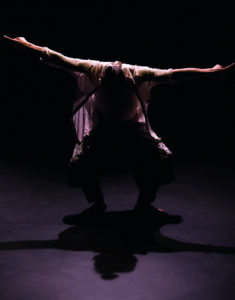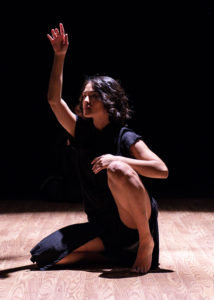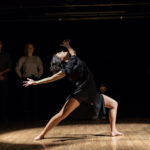Historical Reckoning: Two Japanese Canadians who are dancing their heritage - Vancouver Ballet Society
- Home
- Features 2020 - 2023
- Historical Reckoning: Two Japanese Canadians who are dancing their heritage

By Debra Spark
Kunji Mark Ikeda spent the first 20 years of his life, in Vancouver, “trying to be as white as possible,” he says. Mayumi Lashbrook, raised on the other side of Canada, in Toronto, did the same. “This doesn’t have anything to do with me,” Lashbrook would insist as her mother introduced her to Japanese language, food and culture. Care to visit the Japanese Canadian Cultural Centre? No, thanks. As for Ikeda, his grandmother and aunt were involved in the Japanese-Canadian community in Vancouver, but otherwise his family didn’t particularly emphasize their heritage.
Now Ikeda and Lashbrook are in their early 30s and reflecting on the past has become central to their dance practice, including digging into the most painful part, the Canadian government’s internment of Japanese Canadians during World War Two. Ikeda addresses history head-on in Sansei: The Storyteller, the signature production of Cloudsway Dance Theatre, the Calgary company for which Ikeda is founding artistic director. The solo show braids together the story of Canada’s response to the 1941 Japanese bombing of Pearl Harbor in Hawaii with the legend of a general in feudal Japan and the wartime experience of Ikeda’s family.
Meanwhile, Lashbrook (who is co-artistic director of Aeris Körper in Hamilton, Ontario) is just starting her journey with her own solo, Defined by Bone, which explores personal identity and belonging. Scheduled to premiere at Toronto’s Japanese Canadian Cultural Center in 2021, it will incorporate audio snippets from her grandfather, who the government relocated from British Columbia to work on a Manitoba sugar beet farm, when he was eleven.

Ikeda’s Sansei: The Storyteller is high-energy physical theatre that suits a mainstage space, but has also been performed in more informal locations, including a park in New Denver, in southeastern BC, on the very land on which Ikeda’s family was interned. Lashbrook’s Defined by Bone is intimate and expressionistic, best performed in the round. As suits their different styles, the works were inspired by a story (Ikeda’s) and a feeling (Lashbrook’s).
In tenth grade, Ikeda’s classmates learned about the internment, thanks to a single paragraph in their history textbook. They turned to Ikeda for elaboration, but he had nothing to offer. This was news to him, too. He went home and asked his father, who chuckled and said, “If it weren’t for the internment, I wouldn’t be here, and neither would you.” It turned out that Ikeda’s paternal grandparents had been placed in an internment and a work camp in 1942. When they were reunited, after four years apart, they conceived Ikeda’s father, an “oops” baby, as they hadn’t planned on more children.
All of this might have been the silver lining on a bad experience and not part of Ikeda’s artistic practice if not for a different kind of discrimination. As a young man, Ikeda trained to be an actor but couldn’t find opportunities for people who looked like him. He turned to dance, where he found plenty of opportunities, but even then, he says, “I knew that if I wanted to play a role I was proud of, I had to dig in and create it myself.” And so he did, appearing in pieces he choreographed and wrote, which concerned, among other things, toxic masculinity, video games, sibling rivalry, and wealth and power. But it took yet another encounter with injustice — this time one experienced by Canada’s Indigenous people — to turn him back to his own history.

In 2012, while performing with the Making Treaty 7 Cultural Society, a Calgary organization that explores the significance and repercussions of the historical treaty ceding lands from Canada’s First Nations to Queen Victoria, Ikeda told his cast mates his family’s story. Their interest made him realize he had something to say.
In 2014, Ikeda premiered Sansei, which he has now performed approximately 75 times, typically on a stage strewn with origami. “I am not a very good storyteller,” he opens, before disproving the statement in a manner that is simultaneously friendly, impish and passionate. He narrates through words and movement, physicalizing his material and dramatically embodying experiences of pleasure, pain and rage. He vividly instructs the audience to imagine the stage set that he does not have, then amplifies the effect with archival and familial audio related to the war. The result is entertaining and, surprisingly, funny. “Disarm through comedy” is one of Ikeda’s mottoes. (Ikeda also trained as a clown, and his 2018 Know the Rules, Win the Game uses the history of the taikomochi, a Japanese jester figure, to comment on arts and patronage.)
In one of Sansei’s particularly effective moments, Ikeda manically whips through the tale of a general in feudal Japan who beheads his wives because they cannot produce an heir, when a voice off-stage interrupts to remind him that he is speaking not of a powerful man from the East but the West: King Henry VIII. Then, Ikeda tells the story of a Japanese general who lovingly adopted a child when his wife could not produce an heir.
Like Ikeda’s relatives, Lashbrook’s grandfather was private about his wartime experience. Even so, Lashbrook had reason to think she should question him. When she did, he spoke of surviving by accepting his circumstances, keeping quiet and working hard. Her grandfather’s story triggers Lashbrook because, she says, “he had his whole life taken away” simply because of his Japanese identity.
Lashbrook’s artistic journey has led her from the primacy of “athleticism and illusion” or the “fantastic and showy” in dance toward a gentler somatics. At present, she senses areas of her body “that are lost and under wraps,” but when she turns her attention to her Japanese identity and her grandfather, she says, “I can access those places. They start to crack open.”

When Lashbrook presented a work-in-progress version of the solo in Paris, she performed barefoot in a black cotton dress, dancing almost solipsistically, looking at her palms, rolling, stretching, bending her back and hugging herself while on the floor. Slowly her gestures became broader and more confident, though initially she reeled and stumbled as she engaged with more space. Toward the end, she approached the audience, touching palms with individuals and asking, “Do you trust me?” The music picked up and became increasingly celebratory, a whiff of the dance club in her movements. She took the hands of audience members and what had been a performance became a dance party.
In the pandemic, touch cannot be used to suggest belonging. Rather than postpone her project, however, Lashbrook is learning how to choreograph for a self-operated camera. The plan is for a film within a film, a documentary about the creation of the solo and then the actual solo. The recording of both will be guided by filmmaker Christian Peterson, who has provided Lashbrook with a camera set-up that he will teach her to use over Zoom.
To be titled Things I Cannot Avoid Saying, the project is partly inspired by Lars von Trier’s Five Obstructions, in which von Trier instructs a fellow filmmaker to repeatedly remake an earlier work, each time using an impediment of von Trier’s choosing. In Lashbrook’s case, Peterson will create the “obstructions,” perhaps suggesting she film only shadows or use a single light source when she performs.
Carl Jung believed, “One does not become enlightened by imagining figures of light, but by making the darkness conscious.” Lashbrook’s and Ikeda’s work bears this out. Their reckoning with the past does not re-traumatize or indict, as much as point to the desire for transformation. Lashbrook’s Defined by Bone closes with a joyous group dance; Ikeda’s Sansei: The Storyteller with an anecdote about a hummingbird his uncle found while in internment, a story that highlights the human capacity for wonder. “This is my story. This is who I am,” both dancers might have emphasized with their closing movements. And the statement would be true enough. Instead, their final gestures have a different message: “Join me.”

